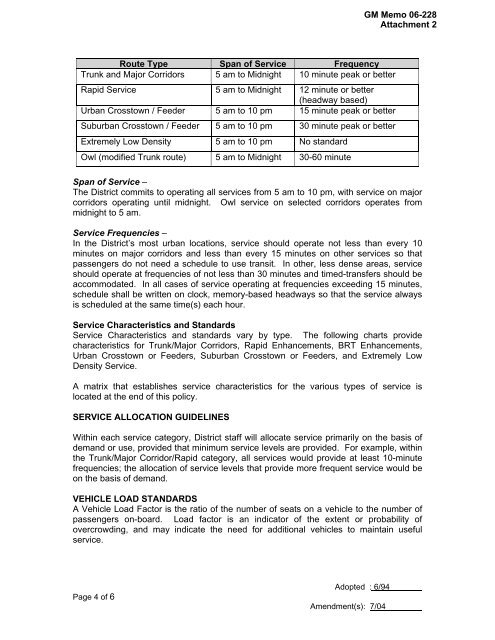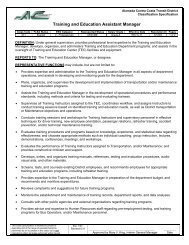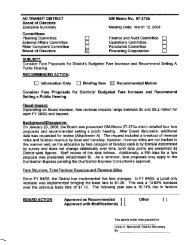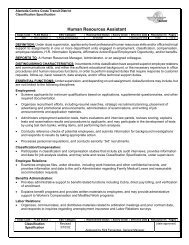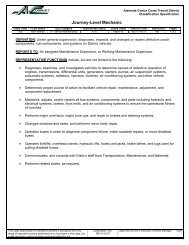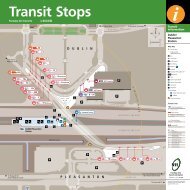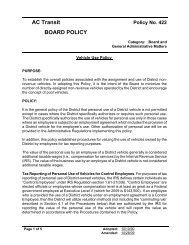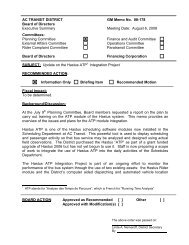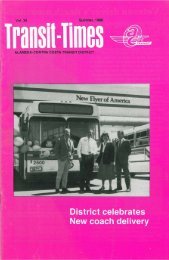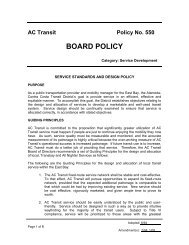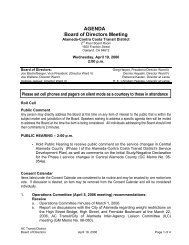AC TRANSIT DISTRICT GM Memo No. 06-228 Board of Directors ...
AC TRANSIT DISTRICT GM Memo No. 06-228 Board of Directors ...
AC TRANSIT DISTRICT GM Memo No. 06-228 Board of Directors ...
Create successful ePaper yourself
Turn your PDF publications into a flip-book with our unique Google optimized e-Paper software.
<strong>GM</strong> <strong>Memo</strong> <strong>06</strong>-<strong>228</strong><br />
Attachment 2<br />
Route Type Span <strong>of</strong> Service Frequency<br />
Trunk and Major Corridors 5 am to Midnight 10 minute peak or better<br />
Rapid Service 5 am to Midnight 12 minute or better<br />
(headway based)<br />
Urban Crosstown / Feeder 5 am to 10 pm 15 minute peak or better<br />
Suburban Crosstown / Feeder 5 am to 10 pm 30 minute peak or better<br />
Extremely Low Density 5 am to 10 pm <strong>No</strong> standard<br />
Owl (modified Trunk route) 5 am to Midnight 30-60 minute<br />
Span <strong>of</strong> Service –<br />
The District commits to operating all services from 5 am to 10 pm, with service on major<br />
corridors operating until midnight. Owl service on selected corridors operates from<br />
midnight to 5 am.<br />
Service Frequencies –<br />
In the District’s most urban locations, service should operate not less than every 10<br />
minutes on major corridors and less than every 15 minutes on other services so that<br />
passengers do not need a schedule to use transit. In other, less dense areas, service<br />
should operate at frequencies <strong>of</strong> not less than 30 minutes and timed-transfers should be<br />
accommodated. In all cases <strong>of</strong> service operating at frequencies exceeding 15 minutes,<br />
schedule shall be written on clock, memory-based headways so that the service always<br />
is scheduled at the same time(s) each hour.<br />
Service Characteristics and Standards<br />
Service Characteristics and standards vary by type. The following charts provide<br />
characteristics for Trunk/Major Corridors, Rapid Enhancements, BRT Enhancements,<br />
Urban Crosstown or Feeders, Suburban Crosstown or Feeders, and Extremely Low<br />
Density Service.<br />
A matrix that establishes service characteristics for the various types <strong>of</strong> service is<br />
located at the end <strong>of</strong> this policy.<br />
SERVICE ALLOCATION GUIDELINES<br />
Within each service category, District staff will allocate service primarily on the basis <strong>of</strong><br />
demand or use, provided that minimum service levels are provided. For example, within<br />
the Trunk/Major Corridor/Rapid category, all services would provide at least 10-minute<br />
frequencies; the allocation <strong>of</strong> service levels that provide more frequent service would be<br />
on the basis <strong>of</strong> demand.<br />
VEHICLE LOAD STANDARDS<br />
A Vehicle Load Factor is the ratio <strong>of</strong> the number <strong>of</strong> seats on a vehicle to the number <strong>of</strong><br />
passengers on-board. Load factor is an indicator <strong>of</strong> the extent or probability <strong>of</strong><br />
overcrowding, and may indicate the need for additional vehicles to maintain useful<br />
service.<br />
Page 4 <strong>of</strong> 6<br />
Adopted : 6/94<br />
Amendment(s): 7/04


